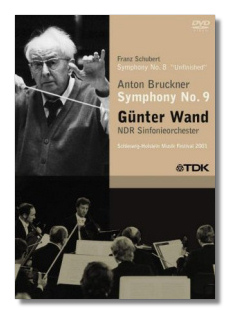
The Internet's Premier Classical Music Source
Related Links
- Latest Reviews
- More Reviews
-
By Composer
-
Collections
DVD & Blu-ray
Books
Concert Reviews
Articles/Interviews
Software
Audio
Search Amazon
Recommended Links
Site News
 DVD Review
DVD Review
Schleswig-Holstein Musik Festival 2001

- Franz Schubert: Symphony #8 in B minor, D. 759 "Unfinished"
- Anton Bruckner: Symphony #9 in D minor
North German Radio Symphony Orchestra/Günter Wand
TDK DVUS-COWAND4 DVD 100min Anamorphic Widescreen LPCM stereo
This was the opening concert at the 2001 Schleswig-Holstein Music Festival in Lübeck – on July 8, to be exact. As the booklet notes point out, these are two "finished unfinished symphonies": the composers intended to complete these works, but did not do so, and they left behind glorious torsos for which it is difficult to imagine truly satisfying completions. This was the last time that Wand was to open the Festival. He died a year later, leaving behind the reputation as being one of the greatest modern-day interpreters of Bruckner's symphonies. During the last 15 years of his life, record companies were eager first to get his studio versions of these works "in the can," and then to follow them up with live recordings. In other words, Wand's admirers are not wanting for choices, and a DVD such as this one (happily) complicates matters even further.
Wand's Schubert is no less insightful than his Bruckner. His reading of the "Unfinished" is slow but never inert – full of gloom and tension in the first movement, and healing song in the second. When the conductor mounts the podium, one is struck by how frail he looks, but there is absolutely no frailty in his music-making. He takes Schubert's symphony about as far as it can be taken without disfiguring it.
The Bruckner is literally awesome. Again, Wand's tempos are much slower here than they were on his studio recording of this work with the Cologne Radio Symphony Orchestra. Even so, the music is in no danger of falling apart. With a sure hand, Wand shapes the phrases into musical paragraphs, and the paragraphs into movements so tightly constructed that they are neither a note nor a moment too long. Even at a slower tempo, the Scherzo loses none of its sinister power, and the climax of Adagio – a scream of existential agony, if there ever was one in Bruckner's music – is shattering. The orchestral work is excellent. A detail here or there would have been tidied up if this had been a studio recording, but it hardly matters in this context.
The cameras allow us to take in Wand's no-nonsense conducting style. More interesting are the close-ups on his face, particularly in the Bruckner, which invite us to guess what he is feeling from one moment to the next. We get to see a lot of the NDR Symphony Orchestra's brass players too. The cameras are almost always where one might want them to be, and there's only a little gratuitous artiness. A full-screen format is used. The sound is LPCM stereo – sorry, no surround format! – but it is full and well-balanced, with a wide dynamic range. Bruckner's climaxes make a complete impact here, in spite of the barn-like construction of Lübeck's Musik- and Kongresshalle.
There is no bonus material, but after hearing Bruckner's Adagio, don't you really need time to recover anyway? The program identifies Schubert's symphony as "No. 7" – the new official numbering, I understand – but the packaging persists in calling it "No. 8."
Copyright © 2006, Raymond Tuttle




















